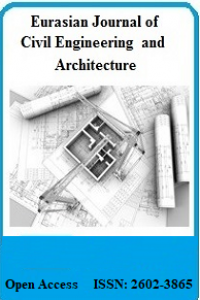INVESTIGATION OF FLUID-STRUCTURE INTERACTION BY USING SOLIDITY RATIO
INVESTIGATION OF FLUID-STRUCTURE INTERACTION BY USING SOLIDITY RATIO
Fluid-Structure Interaction, Hydrodynamic Forces, Solidity Ratio,
___
- A. Korobenko, M. C. Hsu, I. Akkerman, J. Tippmann, and Y. Bazilevs, “Structura lmechanics modeling and FSI simulation of wind turbines,” Mathematical Models and Methods in Applied Sciences, vol. 23, no. 2, pp. 249–272, 2013.
- ANSYS Fluent Users Guide, ANSYS, Canonsburg, PA, USA, 2013.
- CERC. (2002). Coastal engineering manual, Wave Mechanics, Part II, USA.
- Christensen, E. D., Hansen, Yde, E. A. L., Tarp-Johansen, Gravesen, N. J. H., and Damsgaard, M. L., “Wave loads on offshore wind turbine foundations in shallow water: engineering models vs. refined flow modelling,” in Proceedings of the European Offshore Wind Conference, pp. 4–6, Berlin, Germany, December 2007.
- Dagli, B. Y., Tuskan, Y., & Gökkuş, Ü. (2018). Evaluation of Offshore Wind Turbine Tower Dynamics with Numerical Analysis. Advances in Civil Engineering, 2018.
- Ergin, A., 2009. Coastal Engineering. Metu Press. Turkey.
- Friez, P.A., 2011. Offshore Structure Design and Construction. Ships and Offshore Structures. Encyclopedia of Life SupportSystems. UK.
- Karadeniz, H. (2001). Uncertainty modeling in the fatigue reliability calculation of offshore structures. Reliability Engineering & System Safety, 74(3), 323-335.
- Kudale, M. D. and Bhalerao, A. R., “Equivalent monochromatic wave height for the design of coastal rubble mound structures,” Aquatic Procedia, vol. 4, pp. 264–273, 2015.
- Lee, M. M. K., (1999).Strength, stress and fracture analyses of offshore tubular joints using finite elements, Journal of Constructional Steel Research, vol. 51, no. 3, pp. 265–286.
- Nizamani, Z., 2015. Environmental Load Factors and System Strength Evaluation of Offshore Jacket Platforms. Springer International Publishing, Switzerland.
- Telecommunications Industry Association (TIA), 2005, Structural Standards For Steel Antenna Towers And Supporting Structures. USA, 120p.
- Versteeg, H.K., 2007. Malalaseker, An introduction to Computational Fluid Dynamics. The Finite Volume Method. Pearson Education. Longman Scientific Technical. England.
- Wei,K., Arwade, S. R., and Myers, A. T., “Incrementalwindwaveanalysis of thestructuralcapacity of offshore wind turbinesupportstructuresunderextremeloading,” EngineeringStructures, vol. 79, pp. 58–69, 2014.
- Başlangıç: 2017
- Yayıncı: Serkan ŞAHİNKAYA
Ayşe EDİNÇLİLER, Yasin Sait TOKSOY
SURFACE FLOW, URBAN AND LAND-BASED POLLUTION LOADS IN DAVUTLAR BAY
EFFECT OF LIME ON UNCONFINED COMPRESSIVE STRENGTH OF A LOW PLASTICITY CLAYEY SOIL
Mustafa KARASAHİN, Erdinç KESKİN, İlker ŞAHİNOĞLU
INVESTIGATION OF FLUID-STRUCTURE INTERACTION BY USING SOLIDITY RATIO
Begum Yurdanur DAGLİ, Yesim TUSKAN, Dilay UNCU
EXAMINING THE COMPONENTS OF GREEN BUILDING DESIGN AND ITS MANAGEMENT SYSTEM
Mohammad BEYKZADE, Sepide BEYKZADE
